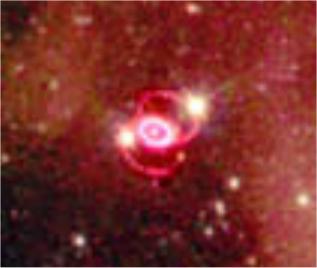In May 1987, astronomers witnessed a once-in-a-lifetime event: a supernova, the explosive death of a supergiant star, in the Large Magellanic Cloud approximately 170,000 light-years from Earth. SN 1987A, as it was named, was the first supernova to be studied using the instruments of modern astronomy (although not the first supernova witnessed by humanity), and produced a wealth of data for scientists.

After the bright initial explosion, SN 1987A gradually faded over the next few months. But then, later in the year, astronomers got a second bonus: three large, glowing rings appeared around the star, lit up as if by a cosmic switch. The prevailing theory is that these rings are clouds of gas puffed off by the star earlier in life, and the intense shock wave of energy emitted by the supernova ionized and heated them to the point of becoming luminous. Among other things, these bright rings were large enough to use for a trigonometric calculation that yields the exact distance between SN 1987A and Earth, providing a useful cross-check for other methods of measuring cosmological distance. And the ongoing study of SN 1987A continues to yield new discoveries, including one just reported in the July 8 issue of the journal Science.
The European Space Agency’s space-based Herschel observatory, which sees in far infrared wavelengths, was surveying the Large Magellanic Cloud and had a chance to observe the dead star. In Herschel’s sensitive vision, the site of SN 1987A was glowing with dim, low-temperature radiation being emitted from a colossal cloud of cold dust surrounding the supernova remnant. This cosmic dust is made up of all the elements heavier than helium – carbon, oxygen, iron, nitrogen, silicon – that were synthesized in the nuclear cauldron of the star’s later life and spewed into space in its death throes.
But what surprised the astronomers was the sheer size of the dust cloud. Being cold and dark, it would have been hard to detect with a less sensitive instrument than Herschel, which is why it went unnoticed until now – but, according to the researchers, there was enough dust blown out of the supernova to create 200,000 Earth-sized planets.
I hope, when you read that number, you feel the same faint tingle of awe that I do. That cold, dark dust cloud enshrouding the dead star potentially contains the seeds of tens of thousands of worlds.
As the supernova remnant expands, most of this dust will dissipate into the cosmic medium, become spread out into space. But some of it may enrich gaseous nebulae where new stars are born, and when the swirling protoplanetary disks around those young suns collapse, they’ll form planetesimals that will be drawn to each other by gravity and coalesce to form new planets. When the fiery heat of their birth subsides, these new planets will have their own continents, their own oceans, their own mountains, their own rivers and seas – and perhaps in time their own life, all made, just as our world and we ourselves are made, of atoms forged millions of years ago in a star’s stupendous death.
We are scions of the universe, and the cosmic process of creation that made us is still going on. Carl Sagan, of course, said it best:
“The Cosmos was originally all hydrogen and helium. Heavier elements were made in red giants and in supernovas and then blown off into space, where they were available for subsequent generations of stars and planets. Our Sun is probably a third-generation star. Except for hydrogen and helium, every atom in the Sun and the Earth was synthesized in other stars. The silicon in the rocks, the oxygen in the air, the carbon in our DNA, the gold in our banks, the uranium in our arsenals were all made thousands of light-years away and billions of years ago. Our planet, our society and we ourselves are built of star stuff.”
170,000 years ago, a sun died in a distant galaxy, and the dispersal of starstuff began anew. The light from that cataclysm only reached our telescopes in 1987, which means that we won’t know for another 170,000 years what’s going on in that region today. It may well be that some of those precious atoms are already engaged in the processes that will one day lead to them becoming part of a living being on a rich and distant world.